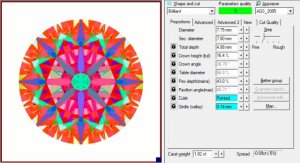You are using an out of date browser. It may not display this or other websites correctly.
You should upgrade or use an alternative browser.
You should upgrade or use an alternative browser.
Thoughts on these diamonds proportions.
- Thread starter cramir
- Start date
- Joined
- Apr 3, 2004
- Messages
- 33,852
- Joined
- May 1, 2008
- Messages
- 3,563
Hello cramir.cramir|1459041971|4011526 said:Can I please get your thoughts and opinions on these diamonds proportions, both HCA 2.4.
RE "get your thoughts on proportions" - Even more important than the base HCA scores, it may help to let you know there are two significant accuracy-issues with GIA report numbers.
(1) Any one number is an average of 8-16 measurements.
(2) That number is also further rounded, in the case of crown angle to the nearest 0.5 degrees.
You're doing good work, researching HCA and such indicators. However, with diamonds in this grey area it's simply hard to make any decisive comment unless you have further data like an ideal-scope or ASET images which permit you to go inside the numbers. And, perhaps predictably, the majority of sellers do not make this easy.
Here is what I mean:
In either of these diamond, taking away rounding, the best case is 56, 40.5, 36.3.
That translates to HCA 1.4 and predicted AGS 1.
Here's a simulated "perfect case" ASET wireframe - this is not possible in reality, so the real diamond will be more limited.
Bear in mind we have no idea of consistency of faceting, indexing variations (painting/digging) or 3D precision.
Just as importantly, we don't know consistency or accuracy of minor facets. So this truly is best case.
But it could be (worst case) 56, 40.7, 36.7.
That translates to HCA 3.1 and predicted AGS 5.
Here's a simulated "perfect case" ASET wireframe - this is not possible in reality, so the real diamond will be more limited.
Bear in mind we have no idea of consistency of faceting, indexing variations (painting/digging) or 3D precision.
Just as importantly, we don't know consistency or accuracy of minor facets. So this truly is best case.
Going farther.
In past years the comment "Additional clouds (or pinpoints) are not shown" in VS2 would not be bothersome. However, many long-producing mines are reaching a point of depletion and shifting to underground mining. As they go to block-caving and bottom-out, more diamonds from those mines come on the market with tint, haze or milkiness that's not fully disclosed on reports. This may be no issue with these specific diamonds, but it's important to have a gemologist you trust assess any diamond you consider spending your money on to verify it's free of any concerns.
One more issue I'd bring to light. These diamonds spread 7.77 and 7.73 mm average. I would expect top-cut diamonds of those mm diameters to weigh around 1.70 carats. Not the 1.80 and 1.82 carats you're considering. Admittedly, this is a small difference. But if the diamonds you're considering do not have edge to edge light return as a result of cut-specifics then these diamonds will not only be perceptually smaller than well-cut 1.80s, due to lesser light return, but they will even be physically smaller.
Ideal-scope or ASET images would help pull back the curtains here.
Hope this is helpful information.


- Joined
- May 1, 2008
- Messages
- 3,563
You're welcome. Regarding the latest diamond; as you probably expected it lands in the same blind area. The only dimensional difference is a 7.74 average diameter, where the prior diamonds had 7.77 and 7.73 averages.cramir|1459100790|4011745 said:Very useful information. Thank you, do you mind running worst and best scenario for this one. I know it has identical proportions but it has different dimensions. Thank you for your input
For all three options above, with the averaging and rounding of many numbers on the report, there is no way to know which (if any) more resembles the best-case, versus which (if any) resembles the worst.
I'd also like to be clear regarding those simulations. The computer presumes perfect wireframes; which are not possible in reality. They don't take into account faceting inconsistency, indexing variations, 3D imprecisions, etc. Depending on those unknowns, the range is potentially even wider. An actual ideal-scope or ASET image is needed if you want to see what lies inside those numbers.
Share:
The Ultimate Guide to Men’s Wedding Bands: Metals, Fit & Finish The Ultimate Guide to Men’s Wedding Bands: Metals, Fit & Finish - 06/27
The Ultimate Guide to Men’s Wedding Bands: Metals, Fit & Finish - 06/27

Chipped Diamonds: Causes, Risks, and What You Should Do About It
Chipped Diamonds: Causes, Risks, and What You Should Do About It - 06/27









300x240.png)